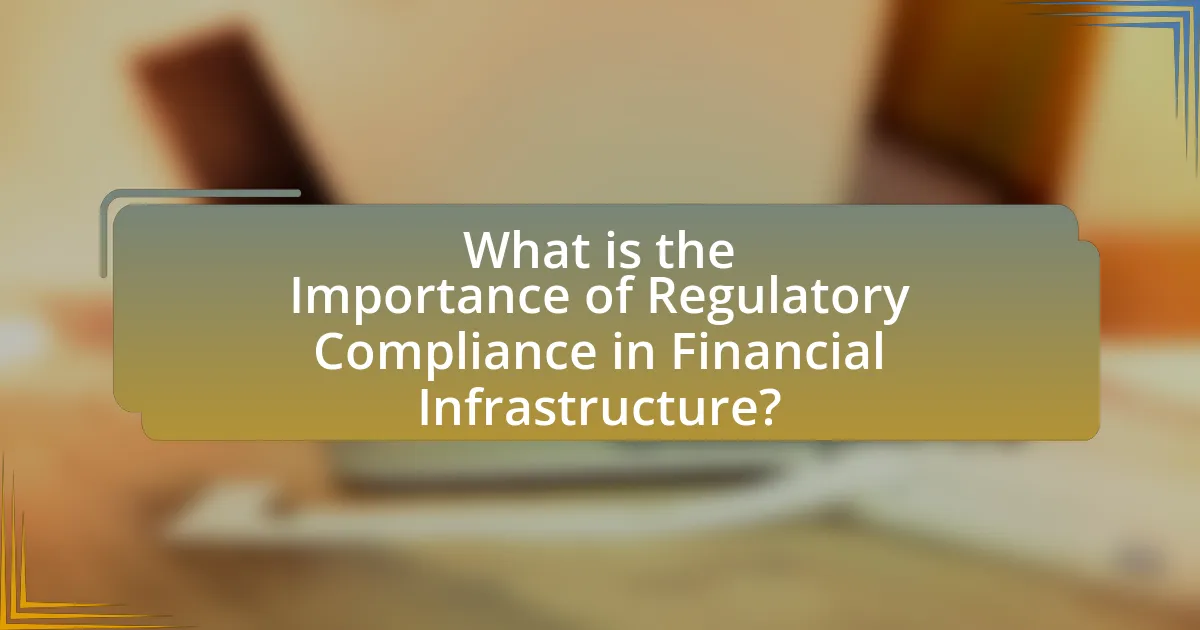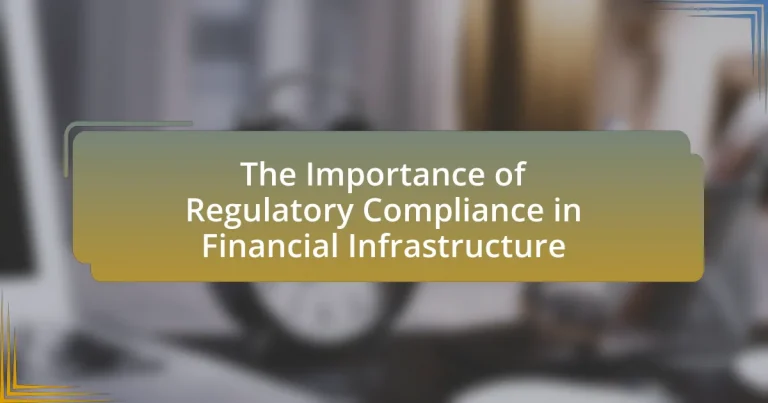Regulatory compliance is a fundamental aspect of financial infrastructure, ensuring the stability, integrity, and transparency of financial systems. This article examines the critical role of compliance in preventing financial crimes, maintaining consumer trust, and fostering fair competition among financial institutions. Key regulations such as the Dodd-Frank Act, Basel III, and PSD2 are discussed, along with their impact on financial operations and the consequences of non-compliance, including legal penalties and reputational damage. Additionally, the article highlights the challenges organizations face in achieving compliance and the role of technology in enhancing compliance efforts, ultimately emphasizing the importance of a robust compliance management system for financial stability.

What is the Importance of Regulatory Compliance in Financial Infrastructure?
Regulatory compliance is crucial in financial infrastructure as it ensures the stability, integrity, and transparency of financial systems. Compliance with regulations helps prevent financial crimes such as money laundering and fraud, thereby protecting consumers and maintaining public trust. For instance, the implementation of the Dodd-Frank Act in the United States post-2008 financial crisis aimed to enhance accountability and transparency in the financial sector, which has been shown to reduce systemic risks. Furthermore, adherence to regulations fosters a level playing field among financial institutions, promoting fair competition and safeguarding against market manipulation.
Why is regulatory compliance critical for financial institutions?
Regulatory compliance is critical for financial institutions because it ensures adherence to laws and regulations designed to maintain the integrity of the financial system. Compliance helps prevent financial crimes such as money laundering and fraud, which can lead to significant financial losses and reputational damage. For instance, the Financial Crimes Enforcement Network (FinCEN) reported that in 2020, banks filed over 100,000 suspicious activity reports, highlighting the importance of compliance in identifying and mitigating risks. Additionally, non-compliance can result in hefty fines; for example, in 2021, a major bank was fined $400 million for failing to comply with anti-money laundering regulations. Thus, regulatory compliance not only protects financial institutions from legal repercussions but also fosters trust among customers and stakeholders, contributing to overall financial stability.
What are the key regulations governing financial infrastructure?
The key regulations governing financial infrastructure include the Dodd-Frank Wall Street Reform and Consumer Protection Act, the Basel III framework, and the Payment Services Directive (PSD2). The Dodd-Frank Act, enacted in 2010, aims to reduce risks in the financial system by increasing transparency and accountability among financial institutions. Basel III, established by the Basel Committee on Banking Supervision, sets international standards for bank capital adequacy, stress testing, and market liquidity risk. PSD2, implemented in the European Union, enhances consumer protection and promotes innovation in payment services by requiring banks to open their payment services to third-party providers. These regulations collectively ensure the stability, security, and efficiency of financial infrastructure.
How do these regulations impact financial operations?
Regulations significantly impact financial operations by imposing strict compliance requirements that govern transactions, reporting, and risk management. These regulations, such as the Dodd-Frank Act and Basel III, enhance transparency and accountability, which can lead to increased operational costs due to the need for robust compliance systems. For instance, financial institutions must invest in technology and personnel to ensure adherence to these regulations, which can divert resources from other operational areas. Additionally, failure to comply can result in severe penalties, including fines and reputational damage, further influencing operational strategies.
What are the consequences of non-compliance in financial infrastructure?
Non-compliance in financial infrastructure can lead to severe legal and financial repercussions. Organizations may face hefty fines, which can reach millions of dollars, as evidenced by the $5.3 billion in penalties imposed on banks for regulatory violations in 2020 alone. Additionally, non-compliance can result in loss of licenses to operate, restricting a company’s ability to conduct business. This can also damage reputations, leading to decreased customer trust and loss of market share. Furthermore, regulatory bodies may impose increased scrutiny and oversight, complicating operational processes and increasing costs. Overall, the consequences of non-compliance can significantly undermine the stability and integrity of financial systems.
What legal penalties can institutions face for non-compliance?
Institutions can face significant legal penalties for non-compliance, including fines, sanctions, and operational restrictions. For example, financial institutions that violate regulations such as the Bank Secrecy Act may incur fines that can reach millions of dollars, as evidenced by the $1.1 billion penalty imposed on Deutsche Bank in 2017 for anti-money laundering failures. Additionally, non-compliance can lead to criminal charges against executives, loss of licenses, and increased scrutiny from regulatory bodies, which can severely impact an institution’s reputation and operational capabilities.
How does non-compliance affect a company’s reputation?
Non-compliance significantly damages a company’s reputation by eroding trust among stakeholders. When a company fails to adhere to regulations, it can lead to negative publicity, loss of customer confidence, and potential legal repercussions. For instance, a study by the Ponemon Institute found that 67% of consumers would stop purchasing from a company that experienced a data breach due to non-compliance with data protection regulations. This illustrates that non-compliance not only invites scrutiny but also directly impacts customer loyalty and brand perception.
How does regulatory compliance enhance financial stability?
Regulatory compliance enhances financial stability by ensuring that financial institutions operate within established legal frameworks, which mitigates risks associated with financial misconduct and systemic failures. Compliance with regulations, such as capital adequacy requirements and anti-money laundering laws, promotes transparency and accountability, thereby fostering trust among investors and consumers. For instance, the Basel III framework mandates banks to maintain higher capital reserves, which has been shown to reduce the likelihood of bank failures during economic downturns, as evidenced by the stability observed in the banking sector post-2008 financial crisis. This adherence to regulatory standards not only protects individual institutions but also contributes to the overall resilience of the financial system, preventing crises that can have widespread economic repercussions.
What role does compliance play in risk management?
Compliance plays a critical role in risk management by ensuring that organizations adhere to laws, regulations, and internal policies, thereby minimizing legal and financial risks. By implementing compliance frameworks, organizations can identify, assess, and mitigate potential risks associated with non-compliance, such as fines, penalties, and reputational damage. For instance, a study by the Association of Certified Fraud Examiners found that organizations with strong compliance programs experience 50% fewer fraud incidents, demonstrating the effectiveness of compliance in reducing risk exposure.
How does compliance contribute to consumer trust in financial systems?
Compliance enhances consumer trust in financial systems by ensuring that institutions adhere to established regulations and standards. When financial entities comply with laws such as the Dodd-Frank Act or the Anti-Money Laundering regulations, they demonstrate a commitment to transparency and ethical practices. This adherence reduces the risk of fraud and financial misconduct, which in turn fosters confidence among consumers. Research indicates that 78% of consumers are more likely to trust financial institutions that prioritize compliance, as it signals reliability and accountability. Thus, compliance not only protects consumers but also strengthens the overall integrity of the financial system.
What are the challenges in achieving regulatory compliance?
Achieving regulatory compliance presents several challenges, including the complexity of regulations, the cost of compliance, and the need for ongoing monitoring and adaptation. The complexity arises from the multitude of regulations that vary by jurisdiction and sector, making it difficult for organizations to understand and implement the necessary requirements. According to a 2021 survey by Deloitte, 60% of financial institutions reported that regulatory complexity is a significant barrier to compliance. Additionally, the financial burden associated with compliance efforts, including hiring specialized staff and investing in technology, can strain resources, particularly for smaller organizations. Furthermore, the dynamic nature of regulations necessitates continuous monitoring and updates to compliance programs, which can overwhelm existing operational frameworks.
What are the common obstacles faced by financial institutions?
Financial institutions commonly face obstacles such as regulatory compliance challenges, cybersecurity threats, and operational inefficiencies. Regulatory compliance is particularly complex due to the constantly evolving legal landscape, which requires institutions to adapt quickly to new laws and regulations, such as the Dodd-Frank Act and GDPR. Cybersecurity threats are increasingly prevalent, with financial institutions being prime targets for cyberattacks; in 2020, 80% of financial services firms reported experiencing a cyber incident. Additionally, operational inefficiencies arise from outdated technology systems, which can hinder the ability to process transactions swiftly and accurately, impacting customer satisfaction and overall performance.
How can technology assist in overcoming compliance challenges?
Technology can assist in overcoming compliance challenges by automating regulatory processes and enhancing data management. Automation tools streamline compliance workflows, reducing human error and increasing efficiency; for instance, regulatory technology (RegTech) solutions can monitor transactions in real-time to ensure adherence to financial regulations. Additionally, advanced data analytics enable organizations to analyze vast amounts of data quickly, identifying compliance risks and ensuring timely reporting. According to a report by Deloitte, 60% of financial institutions have adopted RegTech solutions to improve compliance efficiency, demonstrating the effectiveness of technology in addressing these challenges.
How can organizations ensure effective regulatory compliance?
Organizations can ensure effective regulatory compliance by implementing a robust compliance management system that includes regular training, monitoring, and audits. A compliance management system helps organizations identify regulatory requirements, assess risks, and establish policies and procedures to meet those requirements. For instance, a study by the Association of Certified Fraud Examiners found that organizations with comprehensive compliance programs are 50% less likely to experience regulatory violations. Regular training ensures that employees are aware of compliance obligations, while monitoring and audits help identify gaps and areas for improvement, thus reinforcing adherence to regulations.
What best practices should be implemented for compliance management?
Best practices for compliance management include establishing a robust compliance framework, conducting regular risk assessments, and providing ongoing training for employees. A robust compliance framework ensures that all regulatory requirements are systematically addressed, while regular risk assessments identify potential compliance gaps. Ongoing training equips employees with the knowledge to adhere to compliance standards, reducing the likelihood of violations. According to a study by the Association of Certified Fraud Examiners, organizations with comprehensive training programs experience 50% fewer compliance violations, highlighting the effectiveness of these practices in maintaining regulatory compliance in financial infrastructure.
How can training and education improve compliance awareness?
Training and education enhance compliance awareness by equipping employees with the knowledge and skills necessary to understand regulatory requirements and organizational policies. This process fosters a culture of compliance, where individuals recognize the importance of adhering to regulations to mitigate risks and avoid penalties. Research indicates that organizations with comprehensive training programs experience a 50% reduction in compliance violations, demonstrating the effectiveness of education in reinforcing compliance standards. Furthermore, ongoing training ensures that employees stay updated on evolving regulations, thereby maintaining a high level of compliance awareness within the organization.
What future trends are shaping regulatory compliance in financial infrastructure?
Future trends shaping regulatory compliance in financial infrastructure include the increased use of technology, particularly artificial intelligence and machine learning, to enhance compliance processes. Financial institutions are adopting these technologies to automate compliance tasks, improve risk assessment, and ensure real-time monitoring of regulatory changes. For instance, a report by Deloitte highlights that 80% of financial services firms are investing in AI to streamline compliance operations, indicating a significant shift towards tech-driven solutions. Additionally, the rise of decentralized finance (DeFi) is prompting regulators to adapt existing frameworks to address new risks, emphasizing the need for agile compliance strategies. This evolution reflects a broader trend towards integrating compliance into the core operational framework of financial institutions, ensuring they remain resilient in a rapidly changing regulatory landscape.
How are emerging technologies influencing compliance practices?
Emerging technologies are significantly influencing compliance practices by automating processes, enhancing data analytics, and improving risk management. Automation tools, such as robotic process automation (RPA), streamline repetitive compliance tasks, reducing human error and increasing efficiency. Advanced data analytics enable organizations to analyze vast amounts of data for compliance monitoring, allowing for real-time insights and quicker identification of potential risks. Additionally, technologies like artificial intelligence (AI) and machine learning enhance predictive capabilities, enabling firms to proactively address compliance issues before they escalate. According to a report by Deloitte, 63% of financial services firms are investing in AI to improve compliance and risk management, demonstrating the tangible impact of these technologies on compliance practices.
What changes in regulations can we expect in the coming years?
In the coming years, we can expect significant changes in regulations related to financial infrastructure, particularly focusing on increased transparency, enhanced cybersecurity measures, and stricter anti-money laundering (AML) protocols. Regulatory bodies are likely to implement more stringent requirements for financial institutions to disclose their risk management practices and financial health, driven by the need for greater accountability following recent financial crises.
For instance, the Financial Action Task Force (FATF) has been advocating for stronger AML measures globally, which may lead to more comprehensive compliance frameworks that financial institutions must adopt. Additionally, the rise of digital currencies and fintech innovations is prompting regulators to establish clearer guidelines to ensure consumer protection and market integrity. These anticipated regulatory changes are supported by ongoing discussions in international forums and the evolving landscape of financial technology, indicating a proactive approach to addressing emerging risks in the financial sector.
What practical steps can organizations take to enhance compliance efforts?
Organizations can enhance compliance efforts by implementing a robust compliance management system. This system should include regular training programs for employees to ensure they understand regulatory requirements, as well as the establishment of clear policies and procedures that align with these regulations. Additionally, organizations should conduct regular audits and risk assessments to identify potential compliance gaps and address them proactively. According to a study by the Association of Certified Fraud Examiners, organizations that implement comprehensive training and monitoring programs reduce compliance violations by up to 50%. This evidence underscores the effectiveness of structured compliance initiatives in mitigating risks associated with regulatory non-compliance.


